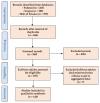What Do We Have to Know about PD-L1 Expression in Prostate Cancer? A Systematic Literature Review. Part 2: Clinic-Pathologic Correlations
- PMID: 34831388
- PMCID: PMC8618408
- DOI: 10.3390/cells10113165
What Do We Have to Know about PD-L1 Expression in Prostate Cancer? A Systematic Literature Review. Part 2: Clinic-Pathologic Correlations
Abstract
Many studies have investigated the potential prognostic and predictive role of PD-L1 in prostatic carcinoma (PC). We performed a systematic literature review (PRISMA guidelines) to critically evaluate human tissue-based studies (immunohistochemistry, molecular analysis, etc.), experimental research (cell lines, mouse models), and clinical trials. Despite some controversial results and study limitations, PD-L1 expression by tumor cells may be related to clinic-pathologic features of adverse outcome, including advanced tumor stage (high pT, presence of lymph node, and distant metastases), positivity of surgical margins, high Grade Group, and castration resistance. Different PD-L1 positivity rates may be observed in matched primary PCs and various metastatic sites of the same patients. Over-fixation, type/duration of decalcification, and PD-L1 antibody clone may influence the immunohistochemical analysis of PD-L1 on bone metastases. PD-L1 seemed expressed more frequently by castration-resistant PCs (49%) as compared to hormone-sensitive PCs (17%). Some series found that PD-L1 positivity was associated with decreased time to castration resistance. Treatment with ipilimumab, cyclophosphamide/GVAX/degarelix, or degarelix alone may increase PD-L1 expression. Correlation of PD-L1 positivity with overall survival and outcomes related to tumor recurrence were rarely investigated; the few analyzed series produced conflicting results and sometimes showed limitations. Further studies are required. The testing and scoring of PD-L1 should be standardized.
Keywords: PD-L1; adenocarcinoma; cancer; checkpoint inhibitors; immunohistochemistry; immunotherapy; prostate; target-therapy.
Conflict of interest statement
The authors declare no conflict of interest.
Figures
Similar articles
-
What Do We Have to Know about PD-L1 Expression in Prostate Cancer? A Systematic Literature Review. Part 4: Experimental Treatments in Pre-Clinical Studies (Cell Lines and Mouse Models).Int J Mol Sci. 2021 Nov 14;22(22):12297. doi: 10.3390/ijms222212297. Int J Mol Sci. 2021. PMID: 34830179 Free PMC article.
-
What Do We Have to Know about PD-L1 Expression in Prostate Cancer? A Systematic Literature Review. Part 1: Focus on Immunohistochemical Results with Discussion of Pre-Analytical and Interpretation Variables.Cells. 2021 Nov 14;10(11):3166. doi: 10.3390/cells10113166. Cells. 2021. PMID: 34831389 Free PMC article.
-
PD-L1 Expression in De Novo Metastatic Castration-sensitive Prostate Cancer.J Immunother. 2019 Sep;42(7):269-273. doi: 10.1097/CJI.0000000000000287. J Immunother. 2019. PMID: 31261165
-
Differential Expression of PD-L1 in High Grade T1 vs Muscle Invasive Bladder Carcinoma and its Prognostic Implications.J Urol. 2017 Oct;198(4):817-823. doi: 10.1016/j.juro.2017.04.102. Epub 2017 May 6. J Urol. 2017. PMID: 28487100
-
PD-L1 Expression and CD8+ T-cell Infiltrate are Associated with Clinical Progression in Patients with Node-positive Prostate Cancer.Eur Urol Focus. 2019 Mar;5(2):192-196. doi: 10.1016/j.euf.2017.05.013. Epub 2017 Jun 21. Eur Urol Focus. 2019. PMID: 28753812
Cited by
-
What Do We Have to Know about PD-L1 Expression in Prostate Cancer? A Systematic Literature Review (Part 6): Correlation of PD-L1 Expression with the Status of Mismatch Repair System, BRCA, PTEN, and Other Genes.Biomedicines. 2022 Jan 22;10(2):236. doi: 10.3390/biomedicines10020236. Biomedicines. 2022. PMID: 35203446 Free PMC article. Review.
-
What Do We Have to Know about PD-L1 Expression in Prostate Cancer? A Systematic Literature Review. Part 4: Experimental Treatments in Pre-Clinical Studies (Cell Lines and Mouse Models).Int J Mol Sci. 2021 Nov 14;22(22):12297. doi: 10.3390/ijms222212297. Int J Mol Sci. 2021. PMID: 34830179 Free PMC article.
-
A Case of Prostatic Signet-Ring Cell-like Carcinoma with Pagetoid Spread and Intraductal Carcinoma and Long-Term Survival: PD-L1 and Mismatch Repair System Proteins (MMR) Immunohistochemical Evaluation with Systematic Literature Review.J Pers Med. 2023 Jun 19;13(6):1016. doi: 10.3390/jpm13061016. J Pers Med. 2023. PMID: 37374005 Free PMC article. Review.
-
Immunotherapy in Prostate Cancer: From a "Cold" Tumor to a "Hot" Prospect.Cancers (Basel). 2025 Mar 21;17(7):1064. doi: 10.3390/cancers17071064. Cancers (Basel). 2025. PMID: 40227610 Free PMC article. Review.
-
What Do We Have to Know about PD-L1 Expression in Prostate Cancer? A Systematic Literature Review. Part 5: Epigenetic Regulation of PD-L1.Int J Mol Sci. 2021 Nov 15;22(22):12314. doi: 10.3390/ijms222212314. Int J Mol Sci. 2021. PMID: 34830196 Free PMC article.
References
-
- National Cancer Institute Surveillance, Epidemiology, and End Results Programs. [(accessed on 29 May 2021)]; Available online: https://seer.cancer.gov/statfacts/html/prost.html.
-
- Falzarano S.M., Ferro M., Bollito E., Klein E.A., Carrieri G., Magi-Galluzzi C. Novel biomarkers and genomic tests in prostate cancer: A critical analysis. Ital. J. Urol. Nephrol. 2015;67:211–231. - PubMed
-
- Tomlins S.A., Alshalalfa M., Davicioni E., Erho N., Yousefi K., Zhao S., Haddad Z., Den R.B., Dicker A.P., Trock B.J., et al. Characterization of 1577 primary prostate cancers reveals novel biological and clinicopathologic insights into molecular subtypes. Eur. Urol. 2015;68:555–567. doi: 10.1016/j.eururo.2015.04.033. - DOI - PMC - PubMed
-
- National Comprehensive Cancer Network (NCCN) Clinical Practice Guidelines in Oncology. Prostate Cancer. Version 2.2021—17 February 2021. [(accessed on 29 May 2021)]. Available online: https://www.nccn.org/professionals/physician_gls/pdf/prostate.pdf.
Publication types
MeSH terms
Substances
LinkOut - more resources
Full Text Sources
Medical
Research Materials


